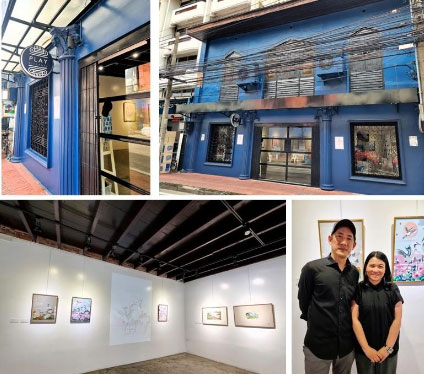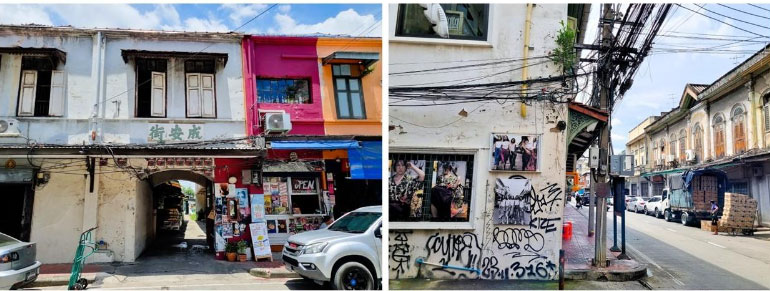BANGKOK, 23 August 2024: Song Wat Street owes its name to King Rama V. In 1906, after a catastrophic fire ravaged Sampheng, the king personally sketched out a new road, stretching straight from the Ratchawong River pier along the Chao Phraya River to Charoen Krung Road, to improve the area’s layout. This 1.2-kilometre thoroughfare, Song Wat, meaning “drawn by the king”, is a tangible testament to His Majesty the King’s urban planning foresight.

Once a vital link to steamship piers and a hub for distributing goods, Song Wat Street played a pivotal role in international trade, handling diverse products from seeds and flours to herbs, soaps, seafood, and even gemstones. This rich commercial history fostered the growth of numerous corporations and firms. The street is home to the historic “Chia Tai” seed shop, today’s Charoen Pokphand Group.
Two decades ago, as the city expanded, a ban on 10-wheeler trucks was implemented in the city centre. Song Wat Street underwent a significant transformation. As businesses struggled with distribution, some adapted while others left, leaving behind empty shophouses. This shift turned the street into a wholesale district for plastics and toys.

Song Wat gained renewed attention around 2016 when it became a canvas for international street artists. A mural featuring two colossal elephants in a playful pose on a building, one of the art exhibition’s highlights, has become a familiar symbol of the street. The infusion of art into the once-forgotten neighbourhood’s fabric has begun to transform Song Wat, attracting those with an interest in arts and lifestyle. New businesses, including cafes, art galleries, and hostels, have emerged, contributing to Song Wat’s evolution into the vibrant place it is today.


Kiattiwat Srichanwanpen, founder of the art gallery PLAY Arthouse and a lifelong resident of Song Wat, has witnessed the neighbourhood’s evolution through three distinct phases. He succinctly captures Song Wat’s essence in three words: “Old Meets New.” A testament to this spirit, Kiattiwat and his wife, Patcharin, transformed his father’s former shoe warehouse into an art gallery. Now one of the icons of Song Wat’s transformation, the gallery’s striking blue exterior is a familiar sight on the street.
“Song Wat has a magnetic pull for the passionate. It’s as if the street invites those genuinely wanting to share their art, craft, or heritage. Drawing on the neighbourhood’s unique energy, these individuals integrate their passions into its expression. PLAY arthouse, founded a few years back, is among examples, born from a vision to showcase art and provide a creative space for all.”

In the post-COVID-19 era, Kiattiwat partnered with young entrepreneurs to form ‘Made in Song Wat’. Together, they organized a small arts and crafts event to revitalize the area. Their efforts successfully drew visitors’ attention. The group also collaborated on creating a guidebook and social media campaign to introduce the area as a destination. By working closely with long-time residents and shop owners and drawing on his deep understanding of the neighbourhood as a resident himself, they established a model for community-driven destinations.

Today, Song Wat is a living canvas where people and time have painted their strokes. The street illustrates its ability to evoke a sense of nostalgia while embracing the future. Beyond the trendy cafés, art galleries, and hostels housed within historic buildings, visitors will discover the legacy of the area’s bustling commercial past. This includes wholesale shops, toy stores, warehouses, second-hand auto parts businesses, known as Xiang Gong, and wood barrels. Even century-old Chinese bun recipes and noodle shops continue to delight. Exploring the surrounding neighbourhoods, one can encounter businesses that have weathered the test of time, dating back to the era of maritime hemp rope and gemstones.
Architecture enthusiasts will find intricate details in century-old shophouses, including woodwork, stucco decoration, and stained glass. Even the aromas tell a story: in one corner, the scent of freshly brewed speciality coffee mingles with the fragrant spices of a neighbouring, old-time Chinese herbal shop.

When asked about Song Wat’s future, Kiattiwat, both an entrepreneur and resident, shared: “I envision Song Wat sustaining its momentum independently, orchestrated and driven by its most valuable resources: its heritage and its people, shaping Song Wat into a destination with its own unique character.”

Exploring Song Wat and its Surroundings:

Preserving the past: Heritage businesses in Song Wat and its neighbouring area keep traditions alive.
The original home of the Charoen Pokphand Group offers a glimpse into the company’s beginnings.

A unique fusion of old and new: FV Cafe combines contemporary art with a traditional wooden house from Mukdahan, nestled in a renovated building in Song Wat.






